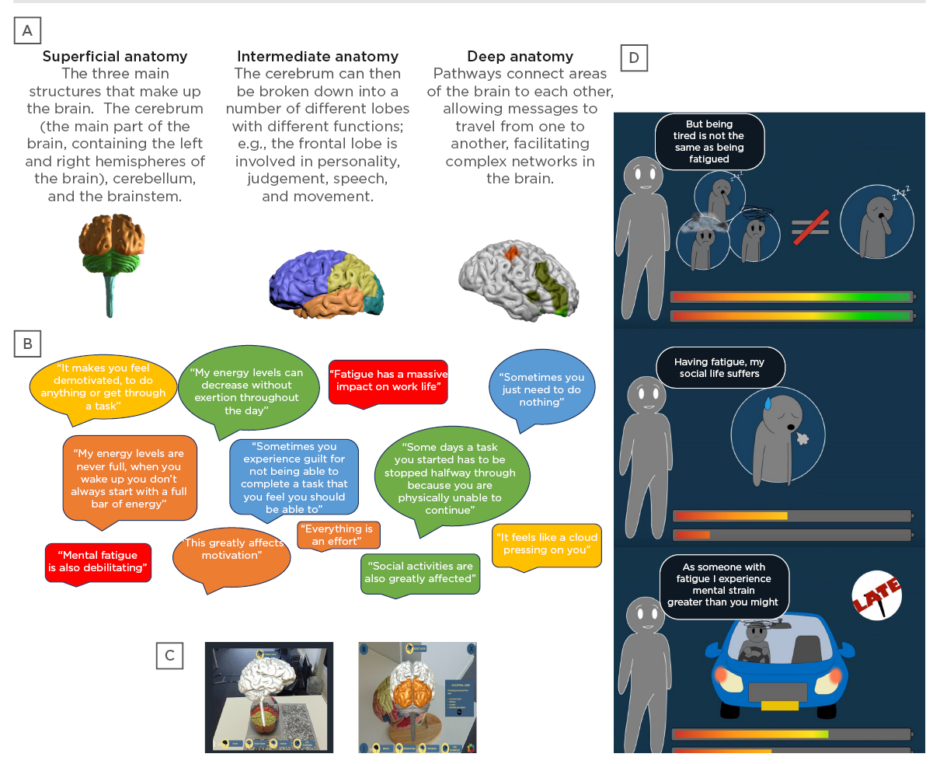BACKGROUND AND AIMS
When discussing the impact of rheumatic disease states with patients living with these conditions, fatigue is often at the forefront of that discussion, as a particularly onerous symptom. In response to this, the authors sought to expand their engagement portfolio to include activities that would help the general public to better understand fatigue and the significant impact it has on those affected. To this end, the authors created an educational application utilising augmented reality and animated videos.
MATERIALS AND METHODS
The application firstly focussed on the brain, helping the user to understand that it is a highly complex organ and reinforcing that there is still much to learn, especially in its role in fatigue. The second part of the application was a short animation from the perspective of someone living with fatigue, explaining its debilitating nature and the severe impact it can have on quality of life.
To create a user-friendly and engaging application, the authors collaborated with Glasgow School of Art and University of Glasgow masters of science in medical visualisation and human anatomy students. The project proposal was also sent to the Glasgow Arthritis Involvement Network (GAIN) patient and public involvement group, who were invited to collaborate on the design and content of the application. In collaboration with GAIN, it was decided that the basic neuroanatomy of the brain would be introduced in three distinct layers (Figure 1A) and that the application would need to carefully guide users, making this complex information as accessible as possible.
The second major discussion point for the group was around the video that would describe the impact of living with fatigue from the perspective of someone who lives with it. Comments from the GAIN members that would be used to help others to understand the debilitating nature of fatigue can be seen in Figure 1B. It was decided that the video would emphasise the variability of fatigue from person to person, and that the tasks affected by fatigue are not limited to work-related activities or household chores, but also affect an individual’s social life. Another important issue included in the animation was the fact that mental fatigue can be just as debilitating as physical fatigue. Finally, it was thought that the video should end by bringing attention back to how complicated fatigue is as a symptom and how this complexity is reflected in the functioning of the fatigued brain.
Some examples of the augmented reality brain aspects of the application can be seen in Figure 1C and some excerpts from the short animation can be seen in Figure 1D.

Figure 1: A) Three distinct layers of brain anatomy; B) Glasgow Arthritis Involvement Network (GAIN) member comments for the educational application; C) interface for the augmented reality brain anatomy; D) excerpts from the short animation surrounding fatigue.
RESULTS
A pilot test was conducted at the Glasgow Science Centre with initial results showing promise in the applications’ educational potential. The percentage of questions pertaining to the brain answered correctly increased from 36% before use to 60% after use of the application. Furthermore, the application also altered the user’s perceptions of the impact that fatigue can have on quality of life: one of the key aims of the project. After using the application, opinions changed to reflect that fatigue can completely impair a person’s quality of life, showing an increase in participants’ understanding of the debilitating nature of fatigue.
CONCLUSION
This study was able to develop an educational application that has shown promise in helping to explain the complex and debilitating nature of fatigue, aiding understanding within the general population.








